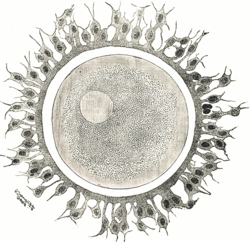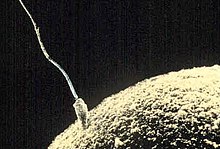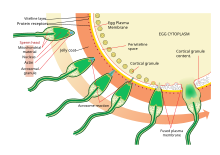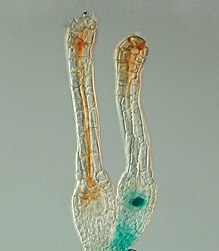Egg cell
Egg cell is the female reproductive haploid cell (gamete) in oogamous organisms. The egg cell is typically not capable of active movement, and it is much larger than the motile sperm cells. When egg and sperm fuse, a diploid cell (the zygote) is formed, which gradually grows into a new individual.
Animals
In animals, egg cells are also known as ova (singular ovum, from the Latin word ovum meaning egg or egg cell). The term ovule is used for the young ovum of an animal. In higher animals, ova are produced by female gonads (sexual glands) called ovaries and all of them are present at birth in mammals and mature via oogenesis.
| Ovum | |
|---|---|
 A human ovum with corona radiata surrounding it | |
| Identifiers | |
| MeSH | D010063 |
| FMA | 67343 |
| Anatomical terminology | |
Human and mammal ova


In viviparous animals (which include humans and all other placental mammals), the ovum is fertilized inside the female body.
The human ova grow from primitive germ cells that are embedded in the substance of the ovaries. Each of them divides repeatedly to give rise to several smaller cells, the oogonia. The oogonia then develop via meiosis into the ova, the primary oocytes, and the polar bodies.[1]
Once the ovum has been fertilized, it begins to divide over the course of a few hours or days, becoming a morula. The morula enters the uterine cavity where it is immersed in the secretions of the uterine glands, ultimately forming a blastocyst.[2]
The ovum is one of the largest cells in the human body, typically visible to the naked eye without the aid of a microscope or other magnification device. The human ovum measures approximately 0.12 mm in diameter.[3]
Ooplasm
Ooplasm (also: oöplasm) is the yolk of the ovum, a cell substance at its center, which contains its nucleus, named the germinal vesicle, and the nucleolus, called the germinal spot.[4]
The ooplasm consists of the cytoplasm of the ordinary animal cell with its spongioplasm and hyaloplasm, often called the formative yolk; and the nutritive yolk or deutoplasm, made of rounded granules of fatty and albuminoid substances imbedded in the cytoplasm.[4]
Mammalian ova contain only a tiny amount of the nutritive yolk, for nourishing the embryo in the early stages of its development only. In contrast, bird eggs contain enough to supply the chick with nutriment throughout the whole period of incubation.[4]
Ova development in oviparous animals
In the oviparous animals (all birds, most fishes, amphibians and reptiles) the ova develop protective layers and pass through the oviduct to the outside of the body. They are fertilized by male sperm either inside the female body (as in birds), or outside (as in many fishes). After fertilization, an embryo develops, nourished by nutrients contained in the egg. It then hatches from the egg, outside the mother's body. See egg (biology) for a discussion of eggs of oviparous animals.
The egg cell's cytoplasm and mitochondria are the sole means the egg is able to reproduce by mitosis and eventually form a blastocyst after fertilization.
Ovoviviparity
There is an intermediate form, the ovoviviparous animals: the embryo develops within and is nourished by an egg as in the oviparous case, but then it hatches inside the mother's body shortly before birth, or just after the egg leaves the mother's body. Some fish, reptiles and many invertebrates use this technique.
Plants
All land plants have alternating diploid and haploid generations. Gametes are produced by the gametophyte, which is the haploid generation. The female gametophyte produces structures called archegonia, and the egg cells form within them via mitosis. The typical bryophyte archegonium consists of a long neck with a wider base containing the egg cell. Upon maturation, the neck opens to allow sperm cells to swim into the archegonium and fertilize the egg. The resulting zygote then gives rise to an embryo, which will grow into a new diploid individual (sporophyte). In seed plants, the archegonia are formed inside a structure called ovule, which contains the female gametophyte. After fertilization, the ovule develops into a seed containing the embryo.[citation needed]
In flowering plants, the female gametophyte has been reduced to just eight cells referred to as the embryo sac inside the ovule. The gametophyte cell closest to the micropyle opening of the embryo sac develops into the egg cell. Upon pollination, a pollen tube delivers sperm into the embryo sac and one sperm nucleus fuses with the egg nucleus. The resulting zygote develops into an embryo inside the ovule. The ovule in turn develops into a seed and in many cases the plant ovary develops into a fruit to facilitate the dispersal of the seeds. Upon germination, the embryo grows into a seedling.[citation needed]

In the moss Physcomitrella patens, the Polycomb protein FIE is expressed in the unfertilised egg cell (Figure, right) as the blue colour after GUS staining reveals. Soon after fertilisation the FIE gene is inactivated (the blue colour is no longer visible, left) in the young embryo. [5]
Other organisms
In algae, the egg cell is often called oosphere.
See also
References
This article needs additional citations for verification. (February 2013) |
- ^ "The Ovum in Gray's Anatomy". Retrieved 2010-02-16..
- ^ Regan, Carmen L. (2001). "Pregnancy". In Worell, Judith (ed.). Encyclopedia of Women and Gender: Sex Similarities and Differences and the Impact of Society on Gender, Volume 1. Academic Press. p. 859. ISBN 9780122272455.
- ^ Search result of "120 micrometers" in Level O Biology - Google books
- ^ a b c "The Ovum". Gray's Anatomy. Retrieved 2010-10-18. Cite error: The named reference "ooplasm" was defined multiple times with different content (see the help page).
- ^ Assaf Mosquna, Aviva Katz, Eva L. Decker, Stefan A. Rensing, Ralf Reski, Nir Ohad (2009): Regulation of stem cell maintenance by the Polycomb protein FIE has been conserved during land plant evolution. Development 136, 2433-2444. doi:10.1242/10.1242/dev.035048
External links
- The Ovarian Kaleidoscope Database description of 1800 genes involved in ovarian functions
